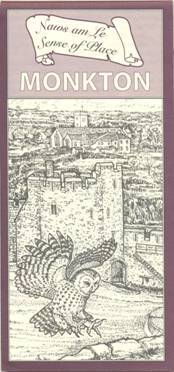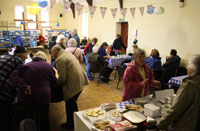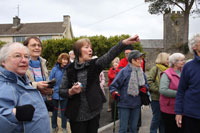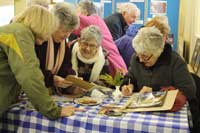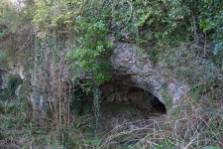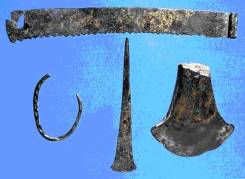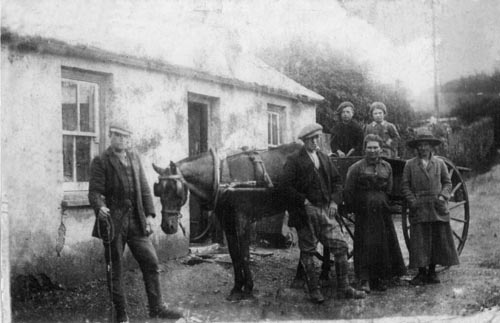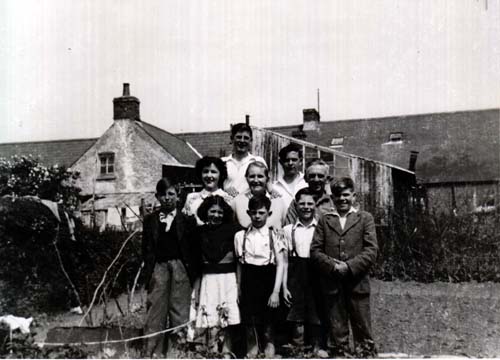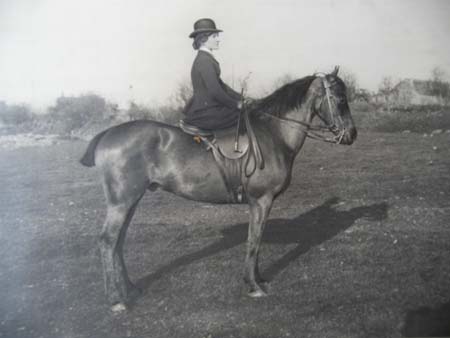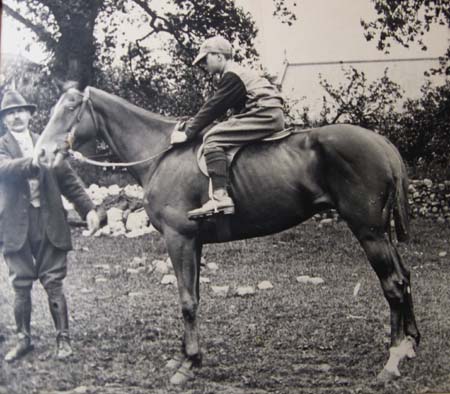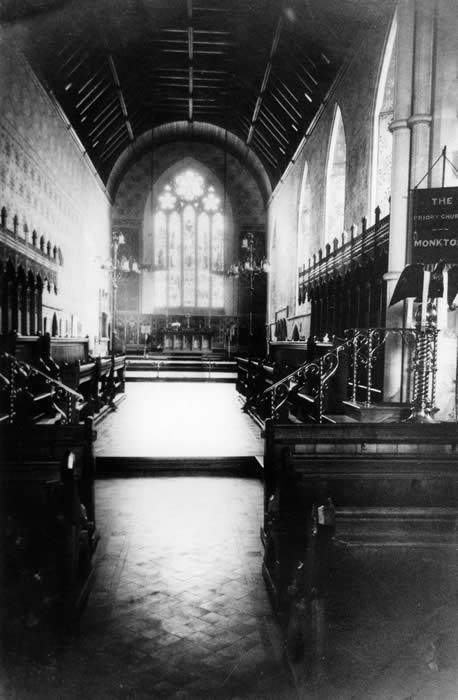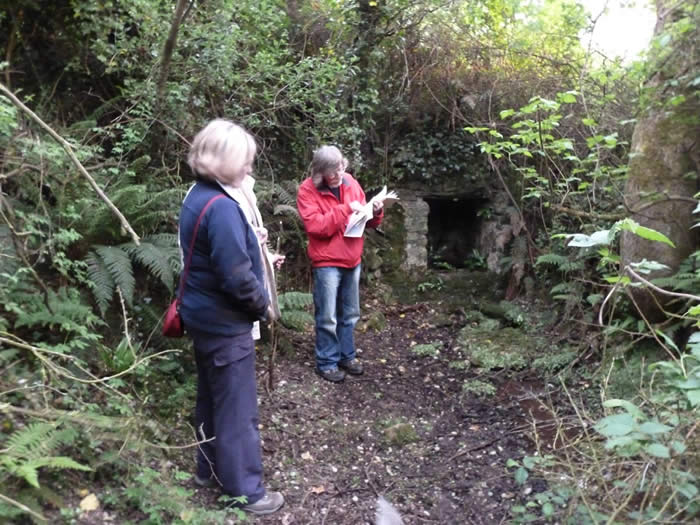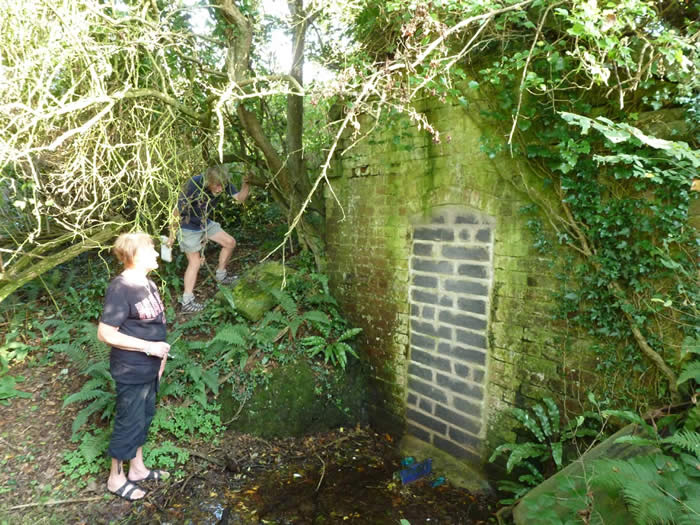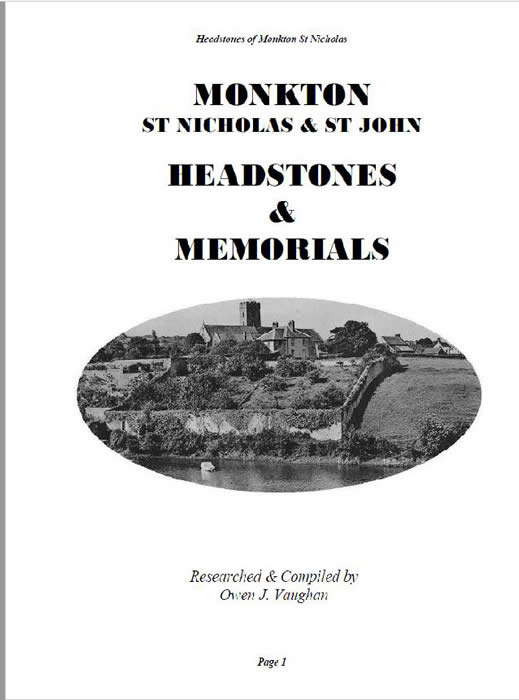MONKTON: A HIDDEN HISTORY
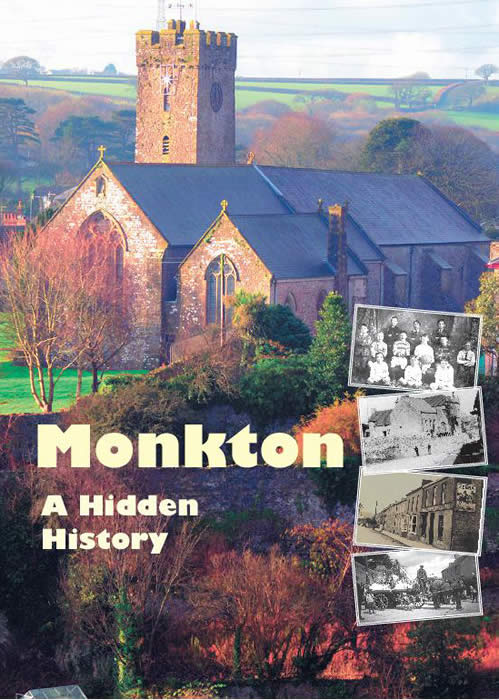
Launched at Pembroke Castle's Christmas Market on 24th November 2022, our latest book ‘Monkton – a Hidden History’. Written by Linda Asman and Keith Johnson, with contributions from many local people, the book brings to light the rich heritage of Monkton which has, until now, been much neglected by historians. Our very first publication was a pamphlet 'Monkton: a Sense of Place', funded by Planed and it has long been our aim to publish a detailed history of Monkton. Thanks to a grant from Heritage Lottery Wales we were able to achieve this. One of the leading members of our Society was the late Pauline Waters and we have dedicated the book to her memory and to all who shared her love of old Monkton.
Unfortunately, demand for this book has exceeded supply but you can view the book here by clicking on the image of the book cover. It is a very large file so it will take time to load.
 
Our Society began with the Monkton History Project!
This led to us working with Planed on a Monkton: Sense of Place leaflet which is available to download here in English and in Welsh. The leaflets are freely available also in Pembroke Town Hall, Tourist Information Centre and Monkton Church.
And here are some interesting glimpses into Monkton's past ...
The Priory Farm Cave
Monkton’s story starts some 10,000 years ago in a cave in the limestone ridge bordering the Pembroke River. This cave called Catshole or Priory Farm cave was excavated in 1908 by Dr A Hurrell Style and Mr E Dixon and found to stretch over 120 feet into the limestone rock. Finds included human and animal remains, flints and a rare bronze age hoard consisting of a saw with ring, chisel and palistrave which can be seen in the National Museum of Wales in Cardiff.
The Founding of Monkton Priory
When Arnulph de Montgomery invaded the area in 1093, he erected a fortification on what is now the site of Pembroke Castle and he also occupied the earthwork where Monkton now stands across the southern inlet of the Pembroke River. Here was established a church and some monastic buildings dating back to the early centuries of the Christian era. This inlet also appears to have been the port or shipping place of the district and was therefore essential to the Norman occupation.
In 1098 Arnulf founded the present Priory making a gift of the Church of St Nicholas "within his castle" to the Benedictine Abbey of Seez in Normandy. The Priory as a parish church became the focus of the settlement of Monkton and gave it its name “tun of the monks”.
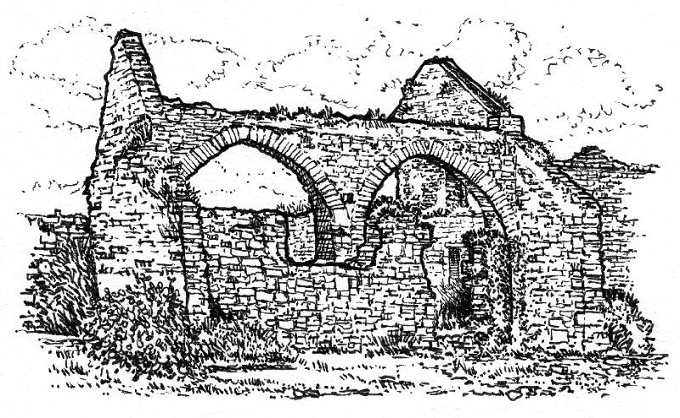
The north side of the nave of the present church is the original wall of the ancient church. The only remains of the Priory buildings, other than what was incorporated into the Priory Church, are limited to some freestanding arches and a gable wall. No archaeological work has been done in the area although aerial photographs and ground forms indicate that extensive foundations remain.
The Priory occupied an important position close to a great castle and on the pilgrim route to St Davids. The young Henry Tudor, who was later to become Henry VII and founder of the Tudor dynasty, was sent to the Priory to be educated by the Benedictine monks. However, it was his son Henry VIII who was responsible for its dissolution in 1535. It continued to be used as a parish church although its condition gradually deteriorated until there remained only the long narrow nave. The choir and sanctuary became a roofless ruin and remained so until its restoration at the end of the nineteenth century.
Medieval Monkton
A cluster of Mediaeval buildings around the Priory fortunately remain which makes “old” Monkton a place of great historic interest.
Monkton Old Hall
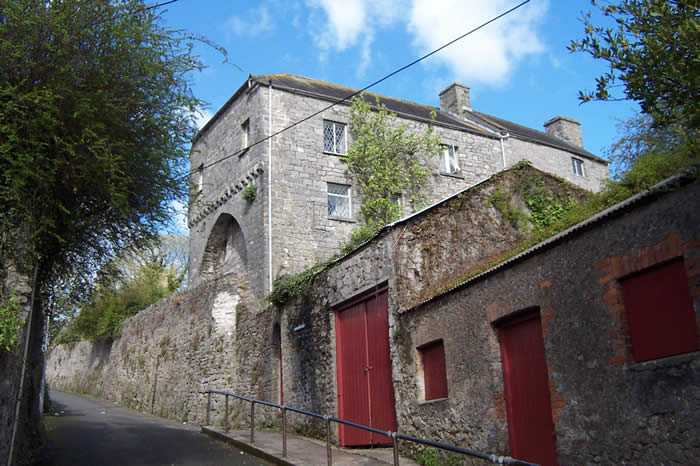 |
The Old Hall is regarded as the oldest domestic dwelling in Pembrokeshire, possibly Wales. Of 14th and 15th century construction it has a vaulted crypt or undercroft, which is much older, and there are many later changes. At the back of the building is a prominent, round “Flemish” Chimney The Hall was not one of the main Priory buildings and is thought to have been a guest house for visitors to the Priory: hospitality was a Benedictine rule. Monasteries were almost the only place where traveller could be sure of a night’s lodgings and perhaps appropriately it is once again a guesthouse owned by the Landmark Trust. It is, however, said to be haunted!
|
Priory Farmhouse
was, according to Fenton, once the Prior’s mansion, it has been very much restored but the corbels high on the front indicate that parts are medieval dating back to the 14th or 15th century. It was originally a fortified manor or tower house built with the main rooms one above the other and accessed by ladder drawn up at night, replaced by a flight of steps as times grew more settled. In the fields a short distance west of the Farmhouse is a mediaeval dovecote, recently unsympathetically renovated by CADW. This would have been important in providing fresh meat to the Priory during the lean winter months. Please note that these buildings are privately owned and there is no right of access.
|
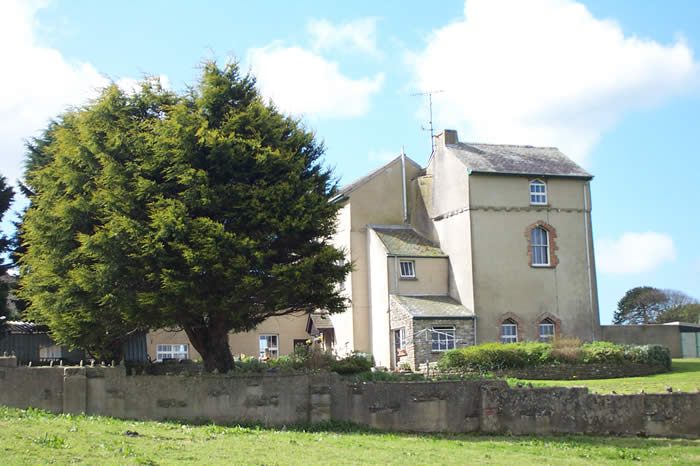 |
17th Century and Civil War
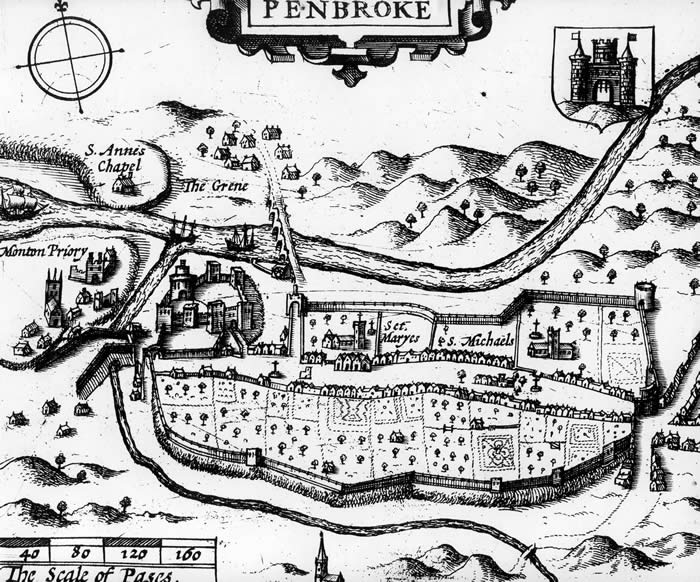
John Speed’s map of 1611 shows the farm complex at Monkton, Monkton was a settlement in it’s own right, with a market from the late mediaeval period onwards.
During the Civil War Cromwell’s troops, numbering in the region of 6,000 men, surrounded the Castle and Monkton occupied an important strategic position. When Cromwell besieged the Castle in 1648 he placed a battery of cannon in the garden alongside the Vicarage. The curate at the time refused to leave his home, preferring to risk the danger and noise. After the siege Cromwell invited him to preach to the officers of his army.
Part of local folklore is the story that Cromwell was able to force Poyer into submission by cutting off the water supply to the Castle which was located in Monkton near the Conduit. A traitor named Edmonds supposedly betrayed the location to Cromwell but he did not benefit from his crime: he was hanged near the spot and a cat stone placed over his grave. That stone was later incorporated into the walls of the old Monkton School and after its demolition taken to the Castle.
Nineteenth Century Expansion
Typical Monkton cottages in Cross Mains and Long Mains - victims of the 1960s clearances
Monkton people engaged in trades connected with shipping, shipbuilding, quarrying and lime working as well as agriculture but it was in the early Victorian times that Monkton rapidly began to spread westwards. Rows of terraced cottages were built to house the workers of the Dockyard as Pembroke Dock increased in size. A rowing boat ferry across the Pembroke River at Colley’s Landing brought workers over to Imble Lane within walking distance of the Dockyard. It is said, that to the Pembroke townspeople Monkton stretched so far west, it seemed it was at the end of the world. That is why there are such exotic names like India Row, New Zealand Row and Turks Castle. Monkton developed into a thriving community. In 1910 the population recorded was 1069 as compared to the 1688 inhabitants recorded in the United Kingdom Census of 2001.
Education
A growing population demanded more and better schools and in 1866 Monkton Mixed Junior School was built on the sharp bend at the top of Bridgend Terrace. This fine Victorian building was a casualty of road improvement and an empty, grassy space remains where it once stood. A new junior School "Monkton Priory Community Primary School" was built behind the Infants which was opened in 1899 and fortunately remains. It incorporates a dedicated centre to gypsy travellers known as the “Monkton Priory School Project”. Monkton has long been associated with the travelling community who are located in Cat’s Hole Quarry and before this in Redstone Quarry.
Farming and Fairs
During the mid 19th century Monkton was the first and last port of call for the farmers and drovers driving herds of cattle from the Castlemartin peninsula. They watered their animals at the Old Conduit in Monkton Lane, and as the cattle needed a drink, so too did the drovers. Church Terrace has 13 properties and at least 5 of these were pubs at this time.
Monkton hosted 3 fairs including the May Fair and the Holyrood Fair and also various street sales of cattle and horses. Horse racing was also a feature of Monkton life. Before moving to Lydstep, the Point to Point races were held at Priory Fields. The Jenkins family of Priory ran stables and owned a string of successful racehorses including the famous Priory Boy.
Victorian Restoration of the Priory Church
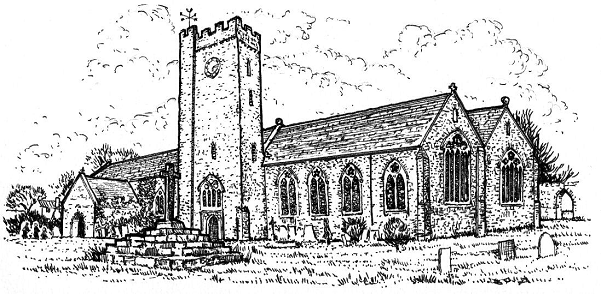
Canon David Bowen came to Monkton in 1877 and was responsible for the restoration of the ruined Priory Church which began in 1882. During the restoration gruesome discoveries were made. Hundreds of human bones were found under the floor and a skeleton of a monk was discovered walled up above the porch, in such a position to suggest he had been interred alive.
King Edward VII and Queen Alexandra visited the Church on Saturday 23rd 1902 and the great East window was commissioned to commemorate the visit, dedicated by the Bishop of Swansea in August 1904. The Queen Mother was another Royal visitor in 1964
The Church is well worth a visit. A leper’s squint and tombs of the local nobility are among its many interesting features, which are highlighted in the Heritage Boards displayed there.
Legend has it that the Priory is connected to the Castle by a secret tunnel. In 1885 two brothers Alfred and Tom Davies claimed to have followed the underground passage. They were driven back by the sound of water and the fact that their lamps went out.
In Search of Ancient Wells
If you think researching our history is all about pouring over books then you are wrong. Members of the Pembroke and Monkton Local History Society have also been trekking over fields, clambering over fences to investigate our past.
Whilst researching Monkton’s history, we came across an entry in the ‘Royal Commission on Ancient Monuments in Wales’ (1922) which listed St Nicholas’s Well. No one seemed to know anything about this well, but we found it described in “Sacred Springs:in search of the Holy wells and Spas of Wales" by Paul Davis. It once served the Benedictine priory and the priors were probably responsible for tapping the source and directing the stream to the Priory along an open culvert. So we decided to go in search of it. With considerable difficulty we found a quite amazing, domed stone chamber, well hidden in undergrowth between fields at the head of the spring. It is this well that actually feeds into the ‘old conduit’ at theWatery Lane junction, opposite Church Terrace and the Priory Church. This is described in our heritage leaflet as the place where once the drovers watered their cattle.
Spurred on by this discovery, we went to look for another Monkton well and close by is Norgan’s well which is rather better known in Monkton’s history. The well is now enclosed in a modern conduit but we found the strucuture to be in a bad way. A tree growing through it has dislodged some of the brickwork and the capping stones are falling away. Breeze blocks now replace the old iron grill which lay discarded on the ground beside it and this had obviously been done recently.
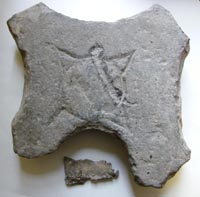 |
Norgan’s Well has a really interesting story attached to it. I first heard this story from
Terry John local historian and Sealed Knot organiser.
In May 1648 Pembroke was besieged by a Parliamentary force of around 6,000 men and for six whole weeks the garrison, led by Pembroke’s mayor John Poyer, held out against the might of Cromwell himself. However, the story goes that Pembroke was forced into submission by the cutting off the water supply which was directed from Norgan’s well along pipes into the castle. Its location was betrayed by a traitor named Edmunds who, it is said, did not benefit from his treachery: he was hanged near the spot and a cat stone placed over his grave. Some people dismiss this story but others believe it: it is in any case part of local legend and it is stories like this which make history so interesting. That being said, the stone does exist. It was later incorporated into the perimeter wall of the old Monkton School and, after its demolition, taken to the Castle.
The Cat Stone is now on show in Pembroke Museum. |
BACK TO TOP OF PAGE |

